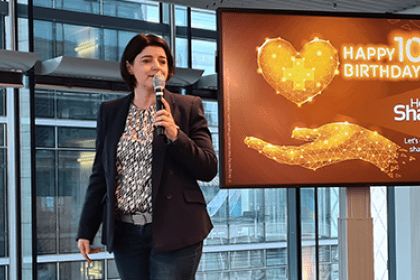
Personalised medicine is the topic at medical congresses and attracts the crowds. The hottest topics are cell & gene therapies and RNA therapies.
The two approved cell therapies, Kymriah (Novartis) and Yescarta (Kite/Gilead) are so-called “CAR-T” therapies, which use autologous cells, i.e., the patient’s own T-cells. In the laboratory, the T-cells are modified using the gene scissors CRISPER to form the CAR surface protein, which is directed against the specific surface proteins of the cancer cell. As a result, after re-infusion of the “boosted” T-cells, the immune system reacts with a strong and sustained immune response against the tumour cells. CAR-T cell therapies are currently approved for ALL (acute lymphoblastic leukaemia), and DLBCL (diffuse B-cell lymphoma). So far, about 300 patients have been treated in Germany with excellent outcomes.
Currently, five gene therapies are approved for the causal treatment of monogenic hereditary diseases, such as Luxturna (Sparks/Novartis) for early retinal dystrophia due to RPE65 mutation, Zynteglo (Bluebird) for beta-thalassaemia and Zolgensma (Biogen) for spinal muscular atrophy SMA, SMN1 mutation.
In both approaches, pathogenic genes are altered; in cell therapy an ex-vivo (outside the patient’s body) process is used, and the “revised” cells are then re-infused. In gene therapy, the correction of the disease-causing gene is achieved in-vivo (inside the patient’s body) using viral vectors as vehicles.
Hypothesis 1:
With cell & gene, fantastic results can be achieved, reminiscent of biblical miracles when “the blind can see again”. However, the cost-intensive nature of these therapies and their disruptive character in terms of responsibility and business models pose major challenges to the health system.
In the context of cell and gene, RNA treatments should also be mentioned. RNA therapies, is an approach already discovered 20 years ago by Prof Tuchel, Göttingen. The idea is to deactivate pathogenic mRNA caused by mutation of the DNA and triggering a disease, with interfering RNA (RNAi), respectively silencing RNA (siRNA). With the development of organ-specific transport vesicles of siRNA therapies such as Onpattro, Glivaari and Oxlumo (Alnylam) are available today. Other very promising siRNA therapies are in development.
Likewise, more and more personalised medicines are becoming available through genetic testing (DNA sequence analysis). Companies like 10x Diagnostics, Illumina, even offer the measurement of active genes in single cells, in their spatial/spatial representation, through transcriptomics.
This makes oncological therapies in particular much more effective. Thanks to diagnostics, drugs can be administered specifically to patients whose tumour disease were caused by mutations in vital processes, such as the G12C mutations in KRAS3, and can now be treated causally with i.e., Lumakras (Amgen). Treating the root cause of diseases meets these patient’s biggest hope.
The use of drugs that have been on the market for a long time, such as ASA, can also be optimised through diagnostics. It could be shown, for example, that prophylaxis of arteriosclerosis is only effective in patients with the risk allele. Otherwise, the administration of ASA is counterproductive. (Hall, Kessler, Chasman, Schuckert, Eu. Heart J, 2019).
“precision medicine” could only be established with the development of molecular diagnostics. On the way to personalised medicine, precision medicine is a major milestone that sets the course away from “one medicine for all” towards specific therapies for defined subgroups. Precision medicine therefore usually goes hand in hand with the joint development of a companion diagnostic and targeted therapy. In recent years, more than 160 biomarkers have been approved in oncology alone. (McKinsey Oncology report 2020)
The benefits of gene-, transcript- and proteome diagnostics and precision medicine are evident for patients. But the benefits are also considerable for the companies that develop these therapies. Eventually, if the therapy is only used in identified target patients, it will be much more effective. Robust evidence accelerates development and market approval as well as simplifies market access processes.
Could personalised medicine be described as the precise diagnosis of genes, mRNA and proteins and cell & gene therapies? Well almost. The NIH defines personalised medicine as:
“Personalised medicine is a branch/field of medicine that uses information about a person’s genes, proteins, and living environment to prevent, diagnose, and treat disease.”
Cell- and gene-therapies are expensive with cost of several hundred thousand up to one million Euros. Getting data on genome, transcriptome and proteome also is also costly. Does this mean that personalised medicine is only restricted to severe diseases such as in oncology and orphan diseases? In these cases, necessarily, but exclusively?
The question is: Can’t personalised medicine be simpler?
For example, do we need a genetic test to see whether we are a man or a woman? Well, mostly not. So-called gender medicine has been showing for many years that medicines affect men and women differently. Awareness of this is growing and has even been the subject of articles in the Public Press i.e., “Bunte” (No. 14, 2021). Nevertheless, almost all drugs in clinical development phases 1 and 2a are tested in men and thus “personalised” for men. It starts with the dose, as men are on average larger and heavier. But pharmacokinetics and pharmacology are also developed on the male system, except for women-specific drugs.
This continues in the training of doctors. In textbooks and even in practices, with the exception of gynaecology, there are anatomical boards depicting a man.
In the evaluations of clinical studies, sub-analyses are carried out in women and men, just as in different ethnic groups. Almost always, the percentages of adverse events are significantly higher in women than in men.
How might a better alternative look like? Differentiate between men and women? Sounds obvious and succinct, but it is far from being implemented everywhere. For example, according to the MELD score, the creatinine value plays a major role in organ allocation for liver transplantation. Since men usually have a higher muscle mass, they reach this value much faster.
Some companies have recognised the issue, and so the VfA can report initial progress in gender-specific development for some drugs: (https://www.vfa.de/de/arzneimittel-forschung/so-funktioniert-pharmaforschung/geschlechtsunterschiede-in-der-medikamentenwirkung.html )
Thesis 2:
Personalised medicine starts with the distinction between men and women!
As in the definition of the NIH, in personalised medicine the life circumstances factor plays just as big a role as genes, i.e., epigenetics, which is the reflection of lifestyle.
Age is certainly one of these life circumstances. Physical fitness, diet, smoking or not smoking, stress also determine “biological” age.
Age is often associated with “adjusted” medical norms. This leads to the question: how are norms formed? A value of a definitely healthy person? According to Wikipedia, medical norms in medicine are empirically collected values of biological measurands that are obtained by examining a large number of “normal” individuals (“sample”), i.e., average values.
Normal is therefore not a targeted definition, but an empirical mean value. Does this mean, in the final analysis, that if the average person is ill, e.g., because he or she is overweight, the overweight becomes the normal value? For a long time, type 2 diabetes was called age-related diabetes, but the weight factor plays a much stronger role than age.
Pulmonary function standard values are also adjusted to age. Athletic people are often up to 50 percent above their respective age percentiles.
General deductions from standard values to individuals can be fatal. For example, in the case of the athletic person, disease-related restrictions in lung function would not be recognised, since they are still in the age percentile.
Thesis 3:
Neither man, nor average, nor age can be the right basis for medical norms for all!
In the digital age, the solution in many cases could be the individual standard norm. Most patients are regularly examined by their family doctor, so that the family doctor knows the individual medical norm, i.e., the values in a healthy state. The electronic patient record (ePA) allows different doctors to access the individual norm values. It can therefore be life-saving. Why is it used so hesitantly?
Thesis 4:
Digitalisation supports individual medical norm!
Meanwhile, 16% of the population use fitness trackers (Statistika 2021), not counting smartphones. A wealth of health parameters such as ECG, heart rhythm or heart rate variability, blood oxygen saturation, mental activity and much more can be continuously recorded via smartphones and other devices.
The wide use of smartphones, the collection and reflection of data, encourages the use of digital health applications (DiGA). Already 15 DiGA are approved, can be prescribed and are reimbursed (diga. BfArM, May 2021).
Similar to diagnostics, precision medicine and new forms of therapy such as cell & gene, digitalisation enables an enormous leap in the quality of medicine on a broad basis. It allows patients to take on a new level of self-responsibility by tracking their lifestyle and compliance with medical recommendations themselves, noting progress and using this as motivation.
Thesis 5:
Digitalisation covers large parts of lifestyle and gives the patient a participatory role!
The Society for Personalised Medicine therefore supplements the definition of personalised medicine and describes it with the 4 Ps: Predictive, Preventive, Personalised and Participating. After all, it is about nothing less than taking medicine to a higher level with the available diagnostic and therapeutic options and thus achieving the noble goal of truly personalised medicine and doing so for the majority of patients, not just the few patients with severe diseases.
CONCLUSION
- New therapies such as cell and gene therapies are highly personalised and represent an enormous quantum leap in medicine.
- Advances in diagnostics make precision medicine possible. They set the course for specific therapy for identified subgroups, rather than medicine for all.
- More “personalised medicine” with all its benefits for a patient can also be achieved by redefining and individualising the norm.
- Digital tools give the patient a participatory role.
- Finally, clinical development or the use of medicines should be much more focused on subgroups, such as gender and genetic disposition.
With these 5 points, personalised medicine is feasible for all.
Abbreviations:
- CRISPR: Clustered Regularly Interspaced Short Palindromic Repeats. This system forms the basis of the CRISPR/Cas genetic engineering method for creating genetically modified organisms.
- CAR-T: chimeric antigen receptor T-cell
- KRAS: Kirsten Rat Sarcoma is an oncogene that encodes a monomeric G protein that plays a crucial role in the proliferation of malignant tumours. It functions as a central element in a number of signal transduction pathways involved in the regulation of growth and differentiation.
- The transcriptome is the sum of all genes transcribed at a given time in a cell, i.e. transcribed from DNA into RNA, i.e. the totality of all RNA molecules produced in a cell (Wikipedia).
- The totality of all proteins in a living being, a tissue, a cell or a cell compartment, under precisely defined conditions and at a specific point in time, is called the proteome (Wikipedia).
- Precision medicine Precision medicine is a medical model that proposes to adapt healthcare, tailoring medical decisions, treatments, practices or products to a subset of patients rather than a model that is appropriate for all. (Wikipedia)
Autoren des Beitrags
Dr. Inge Bliestle
Inge Bliestle, PhD, is an entrepreneur, consultant and mentor with a passion to turn recent R&D findings into patients’ benefits and successful business.














